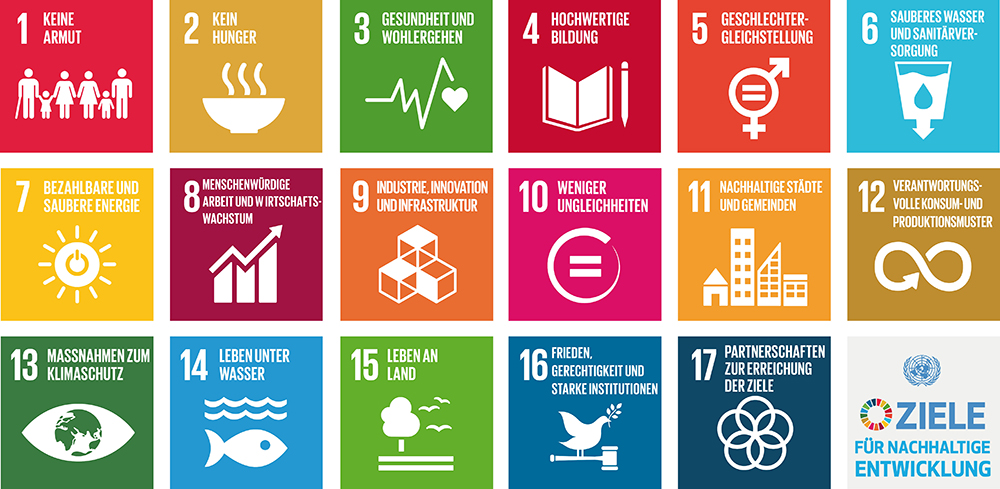SDG Action Plan 2019+
Promoting sustainability and shaping the future is the objective of the systematic approach to the “Agenda 2030” at the Federal Ministry. The present “Action Plan 2019+” demonstrates concrete achievements and initiatives in the implementation of the Ministry’s sustainability policy.

Like all member states of the United Nations, Austria signed the “Agenda 2030” in 2015 and thereby committed itself to the implementation of the 17 Sustainable Development Goals (SDGs).
In January 2016 the Council of Ministers adopted a Decision entrusting all federal ministries with the national implementation of the “Agenda 2030”. Each ministry has to integrate the global Sustainable Development Goals into its relevant strategies and programmes and, if necessary, has to work out suitable action plans and measures.
Process to achieve the SDGs
Activities related to sustainable development have been a priority of the Federal Ministry for many years. It was therefore possible to swiftly prepare a first progress report on the SDGs, which was published in 2017. It documents the manifold initiatives and measures that the Ministry sets to achieve the SDGs. Since 2018 the Federal Ministry has organised its work on the implementation of the Agenda 2030 in an individual, strategically coordinated process. First steps towards the implementation have been summarised and put unto paper in the “SDG Action Plan 2019+” and were published on the Ministry’s website. The Action Plan is to provide guidance for other agencies, too, but also serves as a basis for a possible linkage of non-ministerial sustainability activities to the Federal Ministry.
Instruments of the Action Plan
By means of the Action Plan it becomes transparent in the implementation how the SDGs are anchored within the Federal Ministry’s major fields of competence and activities. The employees of the Ministry get concrete instructions for their areas of work which were developed and implemented in cooperation with the Federal Environment Agency and are based on scientific methodologies.
The instruments used in the process of the SDG Action Plan include, on the one hand, policy analyses (meaning the systematic recording of ongoing implementation activities and their assignment to one or more SDGs affected by them) and activities that build on programme-specific analyses. On the other hand, also test instruments like the “SDG fitness check” or the “ex-ante SDG compatibility tool” are used.
By means of exemplary project analyses the “SDG Action Plan 2019+” provides a broad overview of the ways in which the individual areas of responsibility (Directorates-General) of the Ministry and their activities contribute to the achievement of the 17 SDGs and their 169 targets. This then allows creating policy analyses in a participative expert process.
The “ex-ante SDG compatibility tool” has been created to integrate the SDGs as thoroughly as feasible into the planning and development of the Federal Ministry’s strategies and programmes. It represents a particularly sustainable Agenda 2030 check, which includes a brief presentation of the relevant strategy or the relevant programme as well as a classification and an explanation on how it helps achieve SDGs affected. An evaluation scheme based on scientific experience is used to evaluate the effects, and also the interactions, of selected key measures of the relevant strategy in respect of the thematically relevant SDGs. The “SDG fitness check”, in turn, is mainly applied to existing strategies, programmes and roadmaps. Unlike the detailed ex-ante SDG compatibility tool, it focuses only on the five most important and most pronounced effects.
The “SDG Action Plan 2019+” provides examples for all test instruments that illustrate the application and implementation.
Structure of the Action Plan
After a short methods section, the “SDG Action Plan 2019+” outlines relevant first steps towards the implementation of the SDGs at the Federal Ministry in the form of implementation initiatives. The about 40 initiatives indicated are assigned to the thematic priorities of the BMNT. The surtitles are: “Respect for nature”, “Active hospitality”, “Know where it comes from”, and “Equal opportunities in rural areas”. By means of a rough assessment via a displayed traffic-light system the intensity of the relevant SDG relations is depicted.
An outlook for the further development of the Action Plan and the underlying processes illustrates the planned promotion of the efforts to implement the SDGs. The consolidation of the projects into policy areas and their analyses, the intensified use and further development of the SDG checks and SDG tests (presently, for example, an SDG quick test is being developed) as well as an intensification of the initiatives and measures strategically oriented towards the achievement of the SDGs define the work of the BMNT during the 2019/2020 period. Another objective is to update the “SDG Action Plan 2019+” at regular intervals so as to provide a transparent and documented “status report” of our implementation success and performance.
The comprehensive Annex to the “SDG Action Plan 2019+” comprises numerous initiatives which are listed exemplarily and, together, provide a representative picture of the BMNT’s current activities. For each of the 17 SDGs, implementation initiatives already launched are mentioned. This shows that, in spite of thematic priorities, the BMNT and its activities have an effect on all UN Sustainable Development Goals, which demonstrates interactions and interrelations as well as the wide range of effectiveness in the implementation of the SDGs even more clearly.
Excursus
All activities depicted in the “SDG Action Plan 2019+”, the associated assessments, tests and evaluations of the SDG implementation efforts as well as the work on the issues concerning SDG interactions and options are intended to further improve and visualise the SDG orientation of planned and ongoing initiatives of the Federal Ministry as well as the intensity of the implementation of the Agenda 2030.